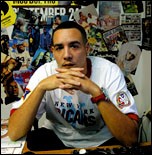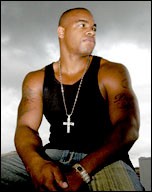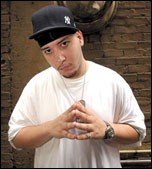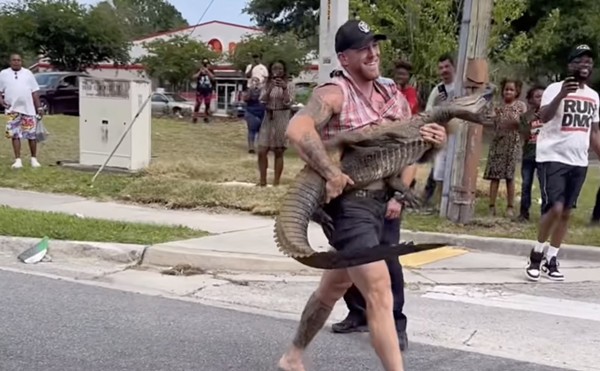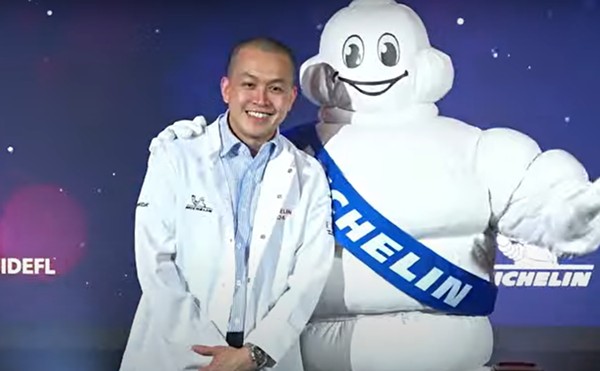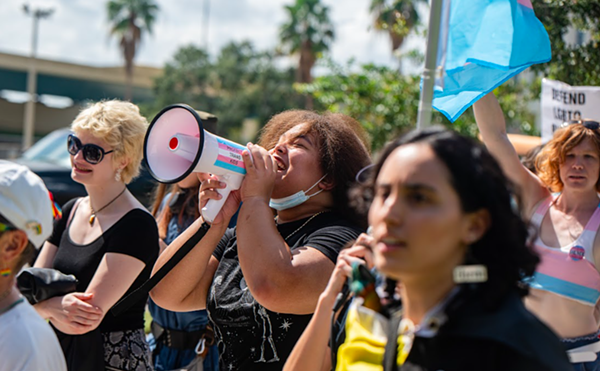In its brief heyday several years ago, Max-A-Million Records was a success story too good to be true. Arising out of the ambitions of an enterprising young man named Wilfredo Rivera Jr., who had no musical training whatsoever, Max-A-Million grew from a small recording studio located in a storage unit at Gore Street and Orange Blossom Trail into the most-happening, most-hyped, hip-hop label in Central Florida. Rivera, whose 5 foot-8 inch, 250-pound frame led family and friends to call him Big Wil, hooked up with some of the area's better underground rappers -- Sonny Chulo, Jonny Bravo, Northstar and Chi-Chi Yeyo -- and recorded a number of demos at a state-of-the-art studio Wil built on Oak Ridge Road.
Big Wil filled his studio with leather couches, vending machines, a large tank stocked with exotic fish, a big-screen television, a high-tech telephone system, high-speed Internet connections, top-of-the-line recording equipment and maps of the United States pinpointing cities his MCs would conquer someday.
Big Wil invited better-known rappers like Cavalucci, considered the Jay-Z of Puerto Rico, to visit the studio, and he treated them like VIPs. When Triple Seis of Terror Squad came down from New York City to record "Dick Ryder" with Sonny Chulo in the summer of 2000, Big Wil put him up in a Disney hotel, gave him passes to the park and took him and his girl to get tattoos at Studio 456.
Big Wil didn't make beats or adjust levels behind the mixing board. As CEO, his job was to take care of everybody. Need a haircut? Big Wil had an account with a barber. Clothes? Big Wil took you shopping. Hungry? Big Wil hauled you to a restaurant. "If Big Wil ate steak, you ate steak; if he ate french fries, you ate french fries," says Sonny Chulo, a 20-year-old, stocky Hispanic rapper who emigrated to Orlando from Spanish Harlem.
Big Wil's open-wallet reputation was so well-known that hustlers would drop by the studio to peddle stuff. One guy sold him a Komodo dragon for a couple hundred dollars, which became the Max-A-Million mascot. "There was a lot of money blown on unnecessary shit," Chulo recalls.
Sure, there were glitches. Phone service was cut at least once because somebody forgot to pay the bill. And Big Wil had to farm out Max-A-Million's graphic designer to help pay the rent.
But nobody thought the good times would end. The Max-A-Million crew was one big family. Big Wil's rappers spent much of their time helping each other cut singles -- not to develop into full-length albums, but to drop onto mixed tapes, which fueled Max-A-Million's hype on the streets. "The MCs had their pictures on flyers all over town," says Big Earl Lugo, a 35-year-old Bronx native who was Max-A-Million's A&R guy. "They had a fan base on the street, and they didn't even have an album out. It was a big gimmick, a marketing thing." Big Wil never even bothered to sign his artists to contracts. He trusted them that much.
But the music business is a fool's paradise. There's nothing like a sure thing, especially when the hype precedes the music, when the street buzz says a certain MC is ready to bust out even though he hasn't recorded a full CD worth of songs.
Toward the end of 2000, Max-A-Million artists became impatient, wondering when the promises of stardom would turn into reality. "When people are young, under 20, egos go crazy," Big Earl says. "They become competitive. It wasn't like we were all working together. They wanted to know, Ã?Why is so-and-so getting all the attention.' Everyone's ego started getting in the way. I saw it coming, and I knew it was going to be trouble."
Rappers bolted for greener pastures. Sonny Chulo defected to Ghetto Savvy, former NBA player Dennis Scott's label. Chi-Chi Yeyo moved to Vegas. Northstar changed his name to Southstar, signed with ArtistDirect and put out a bubble-gum album co-produced by Lou Pearlman that landed the Asian rapper on MTV. Jonny Bravo, with Big Wil's blessings, formed his own production company. Max-A-Million was left with a single artist, D'Ville, a burly, sleepy-eyed R&B singer from Danville, Illinois.
The money also dried up. Checks started bouncing. Ten thousand dollars budgeted for Lugo's A&R account was re-directed to cover the rent. "It went downhill with the record label, people dropping off," says D'Ville, whose real name is Demarcus Wilkins. "It didn't have much income coming in. People started to notice that. They didn't want to stick around for hard times. They wanted to run at a fast pace."
Bravo, a 21-year-old MC from Harlem who lived with Rivera for two years, remembers when Big Wil felt so strongly about Max-A-Million that he paid the studio's rent instead of their MetroWest apartment utility bill. "We had to light fucking candles in this beautiful-ass apartment with no electricity," Bravo says. "This guy started crying. He said, 'I don't care if I have to go through this my whole life.' He was going to keep it popping. He was going to make it happen."
People close to him say Big Wil wasn't bitter. He continued to give advice to Chulo and drove Bravo all the way to New York City to try to sign a deal with another recording company. He moved forward with D'Ville's album and bought a large passenger van, the kind associated with airport shuttles, for road shows. He was excited that D'Ville was booked to open for 50 Cent at the House of Blues in mid-March. "He said, Ã?I know this is going to be it, Mom,'" says Candy Rivera, Wil's mother.
His personal life was also taking off. After admitting himself to the hospital for a case of hypertension, Big Wil dropped 60 pounds and was going to get engaged to his longtime girlfriend, Jessika Rivera. Ozone Magazine, a glossy monthly covering the Miami-Orlando hip-hop scene, was the first to hail Max-A-Million's resurrection. "We're back," announced the headline of the March 2003 edition, showing a spread of Big Wil and his posse throwing the "M" sign for the camera.
Four days later, Big Wil was ambushed outside his small Fern Park office on Highway 17-92, a shady stretch of road overtaken by pawn shops, cheap motels, adult men's clubs, the Jai Alai club and an abandoned retail outlet. According to a Seminole County Sheriff's report, two Hispanic males took Big Wil's own handgun from him and shot him with it. Sheriff spokesman Steve Olson says the two men traveled from New York City to take out Big Wil. "He apparently owed people money," Olson says. "How much money? Enough to make somebody come down from the East Coast to do a hit."
Big Wil died March 9, 2003, seven years to the day hip-hop legend Christopher Wallace, better known as the Notorious B.I.G., died in a hail of bullets outside a Los Angeles club. Unlike Biggie Smalls' death, Big Wil's assassination seems less about gang rivalries than a personal vendetta.
But like Biggie's death, mysteries remain. Were drugs involved? Or was Big Wil so desperate to return Max-A-Million to glory that he turned to a loan shark? Were the New York men actually trying to kill Big Wil, or, as some have suggested, merely send him a message? If the shooting was a hit, why didn't the assassins bring their own weapons?
Those questions might never be answered if the two men, formerly charged under sealed indictments by a grand jury June 9, remain at large and are never arrested and tried.
For now, the people closest to Wilfredo Rivera Jr. are left to consider why a charismatic, middle-class man from a decent Puerto Rican family was gunned down outside his own business.
Taking chances
Wilfredo Rivera Jr. was born December 16, 1971, in the Bensonhurst neighborhood of Brooklyn, the same Italian community north of Coney Island where Joey Fatone of 'Sync grew up. The oldest of three sisters and a brother, Wil liked computers and sports. His parents, Candy and Wilfredo Sr., bought him a Commodore 64 when the home computers were first introduced. He soon moved on to Atari games and Nintendo, where Candy held a job for several years as a graphic artist.
Big Wil was -- quite literally -- an altar boy, at St. Mary Mother of Jesus, a 114-year-old church where, like his siblings, he was baptized and confirmed. Later in life he practiced the faith of many Hispanics, Santeria, which mixes West African religion with Catholicism, emphasizing the belief that humans interact with God through emissaries. The emissaries Big Wil identified with were the American Indians, whom he believed to be our soldiers and protectors.
Rivera's love of sports, particularly football, led to a lot of doctor visits. Candy Rivera remembers her son being in and out of the hospital a number of times for wrenched limbs. He was also prone to household accidents, she says, like the time he sliced four fingers while cutting a bagel and had to be rushed to the hospital for stitches.
Wilfredo Rivera Sr., who goes by the nickname Pete, was a long-distance trucker with the Mayflower shipping company. His routes often took him to Florida, where he fell in love with the sunshine and open spaces. In 1989, Candy and Pete decided to move down with three of their kids.
Big Wil stayed behind, working for the New York Department of Transportation as a draftsman. After a surprise visit to his parents' home in 1991, Big Wil decided to relocate to Orlando, too, bringing along his girlfriend, Denise Vargas, whom he married in 1994. They moved into a beautiful red-brick house in an upper-middle-class neighborhood in southeast Orange County, several miles from Candy and Pete Rivera. (Denise and Big Wil were separated for five years but never divorced; they were still legally married when he died. Countrywide Home Loans foreclosed on their Kaywood Drive house in September 2000.)
At first, Big Wil worked with his father at a manufacturing firm. But his ambitions soon led him elsewhere. He learned how to draw blood and went to work at a doctor's office in 1995. He soon moved on to selling cars at the now defunct Fast Auto Sales dealership, then opened his own car-detailing shop on Colonial Drive and Semoran Boulevard, followed by a car accessory shop on Goldenrod Road called Max-A-Million Auto Center. When that business began to flag, he opened a carpet-cleaning company operated out of his home.
Money didn't seem to be a problem. It flowed in and it flowed out. Big Wil always had a way to make quick cash, buying cars at auction and flipping them to perspective buyers. Candy Rivera, who worked for Orlando Weekly in the early '90s, says risk never bothered her son. "He would say that if you have a dollar today and don't have it tomorrow, that means you took a chance. I don't have half the courage that kid had."
The rap game came to Big Wil on a lark. He convinced Frankie Rivera, who's taller and thinner but shyer than his older brother, to perform in an open-mike night at a Latin disco near Highway 436 and Lake Underhill Road. The next thing Pete Rivera knew, Wil was asking him to help build a studio.
Big Wil discovered Southstar, real name Robert Chapman, rapping in a bathroom at the Palladium, a south-side nightclub. "I pursued him for about a year, and he really wasn't doing anything musically so I persuaded him to come to the studio," Rivera said in the March 2003 issue of Ozone. Big Wil met Sonny Chulo in a Virginia club. Flaco, Big Wil's business partner, convinced Jonny Bravo to come over from Tampa to record at Max-A-Million. And Big Wil and Chi-Chi Yeyo knew each other from hanging out in the clubs.
In some ways, Max-A-Million was truly a family. Sonny Chulo and Jonny Bravo even called Big Wil's parents "Mom" and "Dad." The rappers came over for weekly Sunday dinners, and there was one Thanksgiving at the Rivera house with so many guests that many of them had to sit on the floor, eating turkey off paper plates. The crew often slept at the studio together. "Wil had us rapping every day," Bravo says. "It was fun. It was like rap boot camp for grown men."
Big Wil and his gang solidified their unity by tattooing themselves with the Max-A-Million label, a large "M" framed by two eagle feathers, a salute to Big Wil's love of American Indians. He hauled the Max-A-Million crew to shows in South Beach, Biloxi and New York. He became vice president of Big Life Magazine, the precursor to Ozone, in an effort to promote his crew. His MCs were everywhere. They rapped live over the telephone on pirate radio station 95Live and in just about every club in Orlando -- Empire, the Palladium, Icon, Cairo, Hard Rock, House of Blues, the AKA Lounge. "When we rapped, we rapped," says Sonny Chulo, who won $2,001 dollars in a rap contest. "We didn't just hold our crotches and curse into the microphone."
And still the money kept flowing. Big Earl estimates that at one point in its prime, Max-A-Million spent $100,000 in a single month.
Code of the street
|
Big Earl: There were fans, but no record |
D'Ville: No one stayed for the hard times |
|
Sonny Chulo: If Wil ate steak, so did you |
Sam Perez: Guns weren't part of it |
Where the money came from wasn't exactly clear. Drug money and hip-hop are so closely related, nobody questions the connection anymore. Several people interviewed for this story said they rarely ask people like Big Wil where their funds come from because they don't want to know the answer. "I have had the opportunity with people I know trafficking in drugs who want to get in on my label," says Brian Vasile, who, like Max-A-Million, is hoping to partner his small Washington D.C.-based company, Foundation Records, with a large hip-hop label like Def Jam. "They ask me how they can be an investor. Five grand, 10 grand, whatever, whatever. But I know that side of life, and I know I don't want to be part of it. Does it exist in this business? Hell yeah it does. There's a lot of hip-hop labels built on drug money."
Last year, Suge Knight, owner of Death Row Records, agreed to a plea bargain with federal prosecutors who were investigating, among other things, whether Knight had built his label from the proceeds of drug trafficking. Allegations that Death Row, which launched rap stars Snoop Dogg, Dr. Dre and Tupac Shakur, was underwritten from cash obtained from Compton crack dealers Michael Harris and Patrick Johnson were not corroborated in the investigation. But Knight did accept misdemeanor tax charges to end the probe.
Perhaps the power, mystique and swagger of Suge Knight influenced Big Wil, who emulated aspects of the kingpin. When the Max-A-Million crew posed for the cover shot of Ozone Magazine, the pictured included a Tec-9 handgun inside an open gun case at Jonny Bravo's feet. ("Just some props," Bravo shrugs.) In the corresponding interview, Big Wil was asked about his "Suge Knight reputation for handling disrespect both within and outside your camp."
"Sometimes it takes a bad relationship to start a good relationship," he responded.
That meant using the code of the streets to sort things out. During a concert at Firestone two years ago, a fight erupted between Max-A-Million rappers and members of D12, Eminem's side project, when one of the D12 crew tried to rip a microphone from Northstar's hands. According to one report, Big Wil went "berserk" with a champagne bottle trying to settle the score.
In another incident, several members of Max-A-Million descended on 95Live over a misunderstanding about whether DJ Crook made disparaging remarks about Big Wil's crew. When Wil realized there was a mistake, he tried to make it up to Crook and his partner, Reams. "He resolved it better than I would have been able to," Reams says.
Reams recalls that when his apartment was robbed, Big Wil offered to rough up the perpetrators. "He thought he owed me a favor," Reams says. "When we found some leads, he told me to give him the names, and he would take care of it. That's how much in debt he felt to me." (Reams declined the offer.)
Some of the bravado was, no doubt, posturing, an attempt to look tough to a streetwise hip-hop audience. Except for traffic offenses, Big Wil had no police record in Orange, Seminole or Osceola counties. He had a license to carry a gun from the Florida Department of Law Enforcement. But those closest to him say he rarely carried one. "When I hung out with him, I never saw a gun," says Sam Perez, a rapper known as The Bezerk One, who was helping Big Wil resurrect Max-A-Million at the time he was shot.
Jonny Bravo says Big Wil went along with the image for the sake of the label, but was more interested in company finances than in brawling. "He was a suit-and-tie guy. When we went out, I said, Ã?Don't come with that old-man shit.'"
Bravo says it's ridiculous to think a Max-A-Million artist was ever beat down -- most, like D'Ville were too big and muscular -- though scrapping with other groups was typical. "We had to put a couple of niggas in check in the club," he says.
Wil's family and friends say he didn't deal drugs. "Wil had big investors behind him," says Big Earl, "not drug money like some full-of-shit people are saying in the streets. He knew a lot of people in the luxury-car-sales business. He used to sell cars at one time also. That's how he knew these people. Wil was really good with talking to people and getting them involved in our projects."
Pete Rivera says Big Wil was too much of a family man to be involved in drugs; he dropped by the house three times a week and called on days he didn't.
"I have five kids," adds Candy Rivera. "And he was the one kid I could count on to drop by every single, solitary Sunday to eat dinner with us. He came rain or shine." On weekends he hung out with his brother, Frankie, or 16-year-old sister, Nicole. "He wouldn't let my daughter around anything shady," Candy Rivera says. "He idolized his little sister."
Seminole police, meanwhile, have sent mixed messages about Wil's drug involvement. Interviewed for this story several weeks ago, sheriff's office spokesman Steve Olson said he didn't think drugs were part of the case. "From what I understand, it wasn't drug-related," he said. "He owed somebody money for his business."
But after the grand-jury indictment June 9, Olson became more tightlipped. Asked to confirm Big Wil's death was not drug related, Olson said, "All I can say is that it was a death." It's unclear whether police found additional evidence in the case or were prevented from commenting further by the grand-jury indictment.
According to Candy Rivera, one of the men connected to her son's slaying is wanted on warrants in New York, Connecticut, Puerto Rico and Columbia. "The DEA is looking for him too," she says. Does that raise suspicion that drugs were involved? "No," she concludes. "He's just a bad character."
Still, the people closest to him say there was another side to Big Wil. "He was private with his life," Bravo says. "That motherfucker never tried to break down anything about his life."
Says Pete Rivera: "There was part of his life we knew very little about. We knew what he told us."
What angers Candy and Pete Rivera the most is the thought that their son's killer only intended to wound Big Wil. A single bullet hit him in the shoulder bone and ricocheted through his body, cutting a lung and severing an artery. Big Wil died from massive blood loss. "When you point a gun at somebody, how are you going to tell what happens when you shoot the bullet?" Candy Rivera says. "What lesson is there to be learned? It was a senseless act and what became of it? Did `the killer` get satisfaction?"
Hundreds of people attended Big Wil's funeral, traveling from as far away as New York and Puerto Rico. Rappers printed up T-shirts with a picture of Big Wil flicking the "M" sign at the camera with the slogan "R.I.P. Big Wil" printed at the bottom.
Sonny Chulo says he'll wear the shirt at his next concerts, which he'll dedicate to Big Wil's memory. Jonny Bravo expects to provide for the Rivera household if any of the Max-A-Million recordings, which he's been safekeeping, makes it to the big time. "The shit didn't stop with any bullet," he says.
Big Wil's parents hope an MC takes over Max-A-Million and continues Big Wil's legacy.
Candy Rivera remembers what her son said as the family was returning from a cruise last fall. Passing the luxurious Star Island resort, Big Wil told his mom he would buy her a home there one day. "When I make it, you won't have to worry about a thing," Big Wil said.
"If he was alive now," she says, "I know he would have made it."

